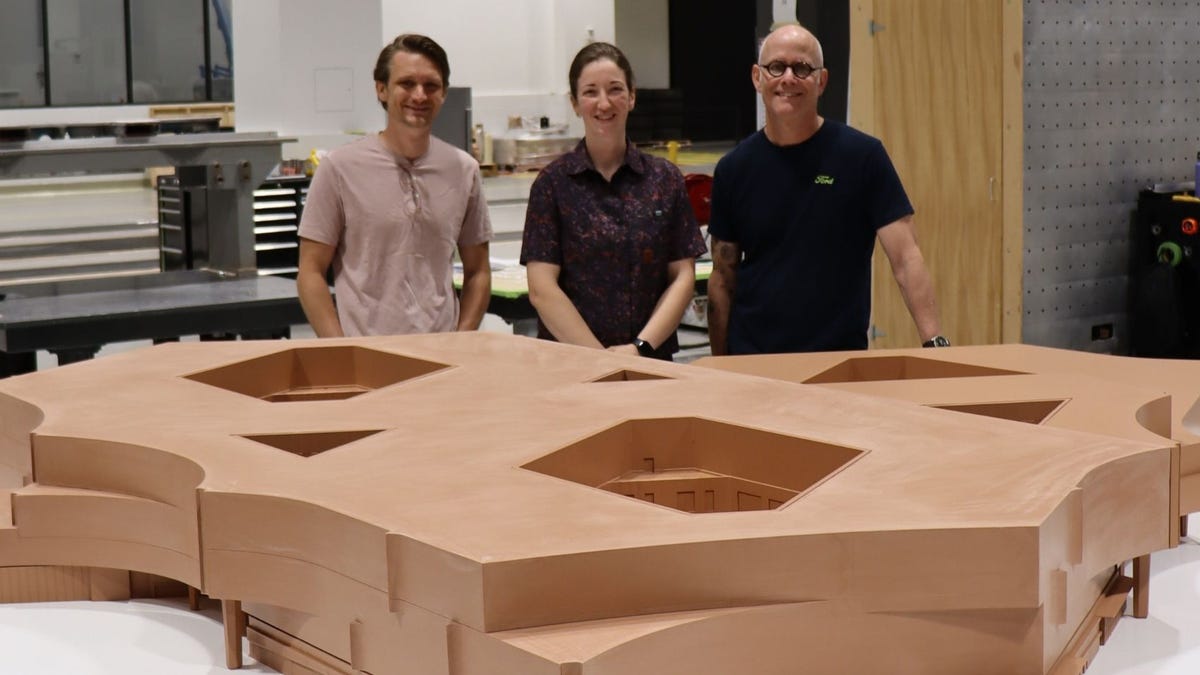Ford Motor Co.’s lead clay sculptor Jeff Royer gets to see Ford’s past and its future on a daily basis.
Royer, who has worked for Ford for 15 years, spends part of his day modeling clay sculptures of cars in what’s left of Ford’s old Product Development Center in Dearborn, Michigan across from The Henry Ford Museum. He then goes to the new studios nearby, in what will soon be Ford’s new world headquarters building, to do the rest of his work.
“I have a foot in the old building and a foot in the new building,” Royer told the Detroit Free Press, part of the USA TODAY Network, on Sept. 15, the day the automaker announced it was moving. “So, daily, it’s a reminder of where we’ve been and where we’re going.”
Ford’s Product Development Center was, at one point, the place to be, Royer said. Now, what is left of it “it is decades old. The new design studios are very human-centric. They put an emphasis on the user in terms of natural light.”
The flood of natural light washing over Royer as he works and other amenities in the new world headquarters not only “buoys” his spirit, Royer said, but it fosters creativity. He believes the environment will lift up the quality of work that comes out of Ford employees once the automaker fills the building with some 4,000 engineers, designers and executives in the next two years.
The new building is, after all, a step into the next century of technological and design advancement for the automaker, many experts said.
“This is all part of Ford building out its future brand and strategy,” said Dan Ives, managing director at Wedbush Securities. “The headquarters is important and it shows Ford taking a leap forward on its innovation path while keeping its 313 roots.”
On the morning of Sept. 15, Ford told its employees and the world the news that shook metro Detroit: The automaker is leaving its iconic World Headquarters building on Michigan Avenue, dubbed the Glass House, for a new World Headquarters in an innovation hub it has been building for five years now located about a mile west of the Glass House on Oakwood Boulevard and Village Road across from The Henry Ford.
The center of gravity in Dearborn shifted on the news, but the move is what many industry observers say Ford needs to do to deliver the best future technology and attract and retain talent.
“The World Headquarters building is 70 years old and I’ve heard stories of it decaying from the inside and it needs one large root canal,” said Jim Seavitt, owner of Village Ford car dealership on Michigan Avenue. “So making this move makes all the sense in the world to me.”
Ford will dedicate the new building on Oakwood Boulevard and Village Road as the new Ford World Headquarters in November. It is four stories high, compared with the Glass House, which is 12 stories. But the new space is double the size in square footage and can hold 4,000 people versus the Glass House’s 2,000 people.
“It’s a big, big building,” Seavitt said. “It looks like the Pentagon.”
Besides being twice the size of the Glass House, the new building is a lot nicer. Mark DePaoli, the newly elected director of UAW Region 1A and former first vice president of UAW Local 600 at Ford’s Rouge Complex, said he expected Ford to relocate its world headquarters after he saw what Ford was building.
“When you see the state-of-the-art facility they put up, it’s a huge building when you compare that to the current world headquarters, which is really outdated and dilapidated,” DePaoli told the Detroit Free Press. “I think they held out this long because of the historical presence of (the Glass House), but this is a much nicer facility.”
DePaoli said for Ford to have its engineering, design and executives housed in one location will help it deliver the best products. But he has some bittersweet feelings, too.
“Henry Ford II put the world headquarters where it was so that he could see the Rouge from his office and, obviously, I’m biased to the Rouge,” DePaoli said. “So I hate to see it go.”
Continuing the Detroit auto legacy: Ford’s numerous world headquarter buildings hold vault of company history
Ford plans to have the Glass House vacated by the second quarter of 2026 and demolish it to make way for a green space in that area by the end of 2027 or middle of 2028.
About 500 employees work in the new building already and another 1,500 employees will start moving into the new world headquarters in October and November. Then, Ford has some more demolition and construction to complete before the remaining 2,000 employees can move in by 2027.
Seavitt said the new location is closer to his dealership, which may boost his business. But he hates to see the Glass House go down.
“My building’s iconic,” Seavitt said of his dealership with the notable round showroom out front, a nod to Ford’s famous Rotunda Center. “I do like iconic things, so I hate to see (the Glass House) come down, but this is the passing of the torch and it’s the right thing to do. They would have spent a lot of money on rehabbing that building.”
Autos analyst David Whiston of Morningstar said Ford is not doing all this just to get new offices. It wants to have more integration between all of its teams and the new facility will be better suited for that than the Glass House. Built in the 1950s, the Glass House was designed with offices that had doors rather than open meeting spaces designed to promote collaboration. Plus, newer facilities may help with recruiting top talent, “people who today would find the Glass House antiquated,” he said.
The move is a significant moment for Ford and metro Detroit, said Mike Ramsey, vice president team manager for automotive, transportation and cross-manufacturing at Gartner Inc. While the Glass House is a “memorable and interesting piece of architecture,” it is situated far from “the heart of the company,” Ramsey said.
“The main campus Ford has been working on, right next to the Henry Ford and its test track, is a more logical place to put the executives,” Ramsey said. “While (the Glass House) was never far, it still created a separation from the executives and the heart of the company.”
The Glass House was one of six world headquarters for Ford in its 122-year history. Ford has used the Glass House since 1956 as its world headquarters. While the automaker has made many historic decisions there that shaped the company, such as the creation of the Mustang in the 1960s and when former CEO Alan Mulally saved the company from bankruptcy in the 2008 Great Recession, industry observers say it is time to move on.
In fact, Erik Gordon a professor at the University of Michigan’s Ross School of Business said this move is “the most symbolic change Ford could make other than replacing the company’s Blue Oval logo. It says that Ford is leaving behind part of its legacy.”
Ford is not the only Detroit automaker to decide to move its world headquarters in recent times.
In April 2024, General Motors said it would move its global headquarters from the Renaissance Center on Detroit’s waterfront to billionaire Dan Gilbert’s new Hudson’s Detroit building on Woodward Avenue in 2025. GM had occupied five of the seven RenCen towers since 1996, when it bought them for pennies on the dollar.
Wayne State University business professor Marick Masters said the opening of a new global headquarters at Ford and GM represents more than a geographical relocation.
“It makes a statement on the importance of opening a new chapter in the organization’s history,” Masters said in an email to the Detroit Free Press. “In this regard, the architecture of a new facility provides an opportunity to explore new approaches to the socio-technological aspects of the design of work and associated human interactions.”
In other words, the companies don’t just want a prettier place to work, they want to see business improve by attracting the best talent and providing employees with new facilities and the latest technology.
“If the move gets more communication between product development and the rest of the company or finance and marketing then it’s probably a good move in the long run,” Morningstar’s Whiston said. “Having on-site studios and garages means executives can go visit those areas quickly and therefore probably more frequently. Real time feedback can ultimately make a vehicle’s journey to market faster.”
Art Wheaton, director of labor studies at Cornell University’s School of Industrial and Labor Relations said relocating a world headquarters is significant also because it shows the long-term economic forecasts are not too bad if Ford is willing to invest in new construction. Ford declined to say how much it is spending on the new world headquarters complex, but project cost estimates in 2016 were $1.2 billion.
Wheaton said it also highlights the desire to be more integrated into the design and engineering process and less of the “Glass House” filled only with executives.
“Third, it highlights the changing needs of building design,” Wheaton said in an email. “Having more amenities in the workplace (restaurants, etc.) shows the company values the employees and makes the workplace more accommodating. Staying in Dearborn shows it is not a cost-saving mission in search of lower taxes and encouraging employees to leave like an out-of-state move might.”
Ford is already showing what can be done in the new facility by synthesizing the automotive industry with the architecturual world. Royer and 35 other employees made a clay sculpture of the new World Headquarters, the first such re-creation in the history of Ford.
Royer has been coming to work in both the old PDC and the new Hub since late May, and the team spent about five weeks creating a clay architectural model of the new World Headquarters building, even as construction on the real building continued around them.
The new 2.1-million-square-foot headquarters building will house six studios and a first-floor fabrication department for painting and rapid prototyping, as well as wood, metal and trim creation.
Royer, who worked as an architect before joining Ford 15 years ago, said the miniature clay world headquarters will be something people can use to navigate the real-life gigantic space.
“It was actually an idea that came from another group that was helping put together a narrative about the new building,” Royer said of the clay model. “It was their brainchild to say: They do clay models all the time of cars; what if they did a clay model of the building? That is a very unique way to represent an architectural project versus a traditional means of doing architectural models of paper and wood.”
Ford said its team used large-scale 3D printing that is available at the new world headquarters to produce the detailed center courtyards of the clay model. Also, a custom wood table was built to support the model, which will remain on display at the new World Headquarters beyond the Sept. 15 grand opening.
Jamie L. LaReau is the senior autos writer who covers Ford Motor Co. for the Detroit Free Press. Contact Jamie at jlareau@freepress.com. Follow her on Twitter @jlareauan. To sign up for our autos newsletter. Become a subscriber.












